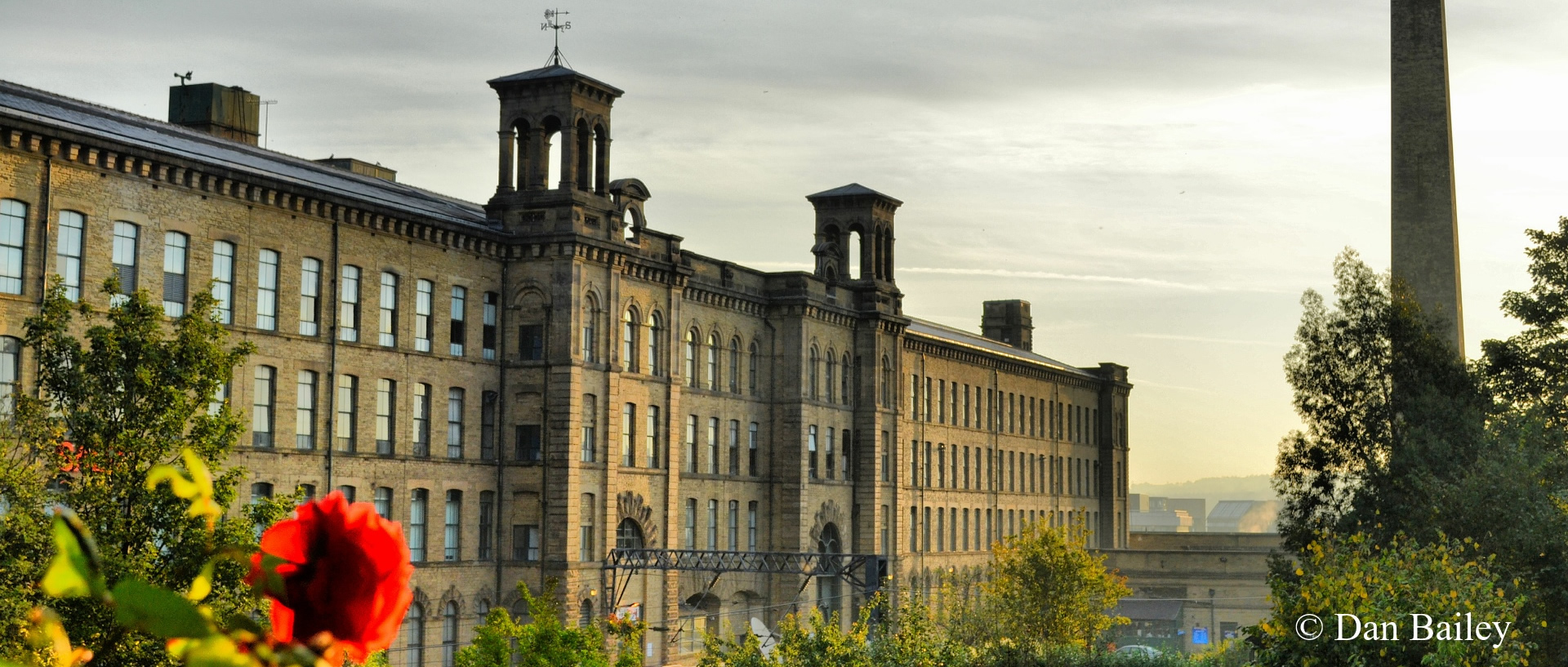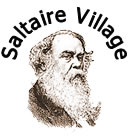Saltaire - the initial plan
These notes are extracted from the Word Heritage Committee Nomination Document, 2001. You can download this comprehensive document from this website.
[You will need Acrobat Reader. If you don't have Acrobat Reader, you can download the software FREE. GET ACROBAT READER - FREE!] GET ACROBAT READER - FREE!]
Photographs and images are additional and are credited.
Saltaire was built as a single, planned model industrial village between 1851 and 1876. It was consistently constructed from natural materials - a warm coloured local sandstone and Welsh slate, generally in the Italianate style. The Mill was built before the houses, as it would take time for it to be fitted out and become operational. Immediately after its official opening in 1853,work began on the rest of the village and continued until 1876.
The concept was devised and realised by Titus Salt, who was a man of high ideals and advanced social consciousness, as well as a successful businessman. The plan of Saltaire and the design of its buildings were the responsibility of the architects, Henry Lockwood and William and Richard Mawson, who were experienced in civic and industrial design. Salt's engineer, William Fairbairn,was accepted as one of the finest engineers available.
Saltaire was built on a gridiron plan, with its roads named after Queen Victoria and her consort, Albert, after members of Salt’s family, and the architects, Lockwood and Mawson. The first phase of road construction saw the streets organised on a north-south orientation. The latter phase was constructed east-west, so that the external appearance of the village from the Bradford to Bingley road was enhanced. Almost all the grand public and community buildings were buil ton Victoria Road,which led to the Mill. Most of the housing was built in the west of the village. |
Saltaire's exact position
N53 50 21 W1 47 18

Saltaire's inscription as a World Heritage site
SITE NAME: Saltaire
DATE OF INSCRIPTION: 16th December 2001
DECISION OF THE WORLD HERITAGE COMMITTEE:
"The Committee inscribed the Saltaire on the World Heritage List under criteria (ii) and (iv):
Criterion (ii): Saltaire is an outstanding and well preserved example of a mid 19th century industrial town, the layout of which was to exert a major influence on the development of the "garden city" movement.
Criterion (iv): The layout and architecture of Saltaire admirably reflect mid 19th century philanthropic paternalism, as well as the important role played by the textile industry in economic and social development."
UNESCO: "Saltaire, West Yorkshire, is a complete and well-preserved industrial village of the second half of the 19th century. Its textile mills, public buildings and workers' housing are built in a harmonious style of high architectural standards and the urban plan survives intact, giving a vivid impression of Victorian philanthropic paternalism."

WH Sites in the UK
(GB & Northern Ireland)
 Cultural site Cultural site
 Natural site Natural site
 Mixed site Mixed site
 Castles and Town Walls of King Edward in Gwynedd (1986) Castles and Town Walls of King Edward in Gwynedd (1986)
 Durham Castle and Cathedral (1986) Durham Castle and Cathedral (1986)
 Giant's Causeway and Causeway Coast (1986) Giant's Causeway and Causeway Coast (1986)
 Ironbridge Gorge (1986) Ironbridge Gorge (1986)
 St Kilda (1986, 2004, 2005) St Kilda (1986, 2004, 2005)
 Stonehenge, Avebury and Associated Sites (1986) Stonehenge, Avebury and Associated Sites (1986)
 Studley Royal Park including the Ruins of Fountains Abbey (1986) Studley Royal Park including the Ruins of Fountains Abbey (1986)
 Blenheim Palace (1987) Blenheim Palace (1987)
 City of Bath (1987) City of Bath (1987)
 Frontiers of the Roman Empire (1987, 2005) * 27 Frontiers of the Roman Empire (1987, 2005) * 27
 Westminster Palace, Westminster Abbey and Saint Margaret's Church (1987) Westminster Palace, Westminster Abbey and Saint Margaret's Church (1987)
 Canterbury Cathedral, St Augustine's Abbey, and St Martin's Church (1988) Canterbury Cathedral, St Augustine's Abbey, and St Martin's Church (1988)
 Henderson Island (1988) Henderson Island (1988)
 Tower of London (1988) Tower of London (1988)
 Gough and Inaccessible Islands (1995, 2004) 28 Gough and Inaccessible Islands (1995, 2004) 28
 Old and New Towns of Edinburgh (1995) Old and New Towns of Edinburgh (1995)
 Maritime Greenwich (1997) Maritime Greenwich (1997)
 Heart of Neolithic Orkney (1999) Heart of Neolithic Orkney (1999)
 Blaenavon Industrial Landscape (2000) Blaenavon Industrial Landscape (2000)
 Historic Town of St George and Related Fortifications, Bermuda (2000) Historic Town of St George and Related Fortifications, Bermuda (2000)
 Derwent Valley Mills (2001) Derwent Valley Mills (2001)
 Dorset and East Devon Coast (2001) Dorset and East Devon Coast (2001)
 New Lanark (2001) New Lanark (2001)
 Saltaire (2001) Saltaire (2001)
 Royal Botanic Gardens, Kew (2003) Royal Botanic Gardens, Kew (2003)
 Liverpool – Maritime Mercantile City* (2004) (*In danger) Liverpool – Maritime Mercantile City* (2004) (*In danger)
 Cornwall and West Devon Mining Landscape (2006) Cornwall and West Devon Mining Landscape (2006)
 Pontcysyllte Aqueduct and Canal (2009) Pontcysyllte Aqueduct and Canal (2009)
 The Forth Bridge The Forth Bridge
 Gorham's Cave Complex Gorham's Cave Complex
 The English Lake District The English Lake District
 Jodrell Bank Obervatory Jodrell Bank Obervatory
See the list for the rest of the world >> |
World Heritage Nomination File
The Nomination File was prepared for Saltaire's bid to gain World Heritage status. It has great information about Saltaire's history and architecture as well as some interesting images.
Download the Nomination File. (21.8 mb)

How many WH sites are there?
Currently, there are 1121 World Heritage Sites approved by the World Heritage Committee as having outstanding universal value. These include 869 cultural sites (Saltaire is one of these), 213 natural sites and 39 mixed mixed site properties (info correct, May 2020).
Link to UNESCO World Heritage Sites
UNESCO list >

Info on UNESCO
 UNESCO is the United Nations Educational, Scientific and Cultural Organization. UNESCO is the United Nations Educational, Scientific and Cultural Organization.
UNESCO was founded on 16 November 1945.
"UNESCO functions as a laboratory of ideas and a standard-setter to forge universal agreements on emerging ethical issues. The Organization also serves as a clearinghouse – for the dissemination and sharing of information and knowledge – while helping Member States to build their human and institutional capacities in diverse fields. In short, UNESCO promotes international co-operation among its 193 Member States and six Associate Members in the fields of education, science, culture and communication."

UNESCO and Heritage
"Heritage is our legacy from the past, what we live with today, and what we pass on to future generations. Our cultural and natural heritage are both irreplaceable sources of life and inspiration. Places as unique and diverse as the wilds of East Africa’s Serengeti, the Pyramids of Egypt, the Great Barrier Reef in Australia and the Baroque cathedrals of Latin America make up our world’s heritage.
What makes the concept of World Heritage exceptional is its universal application. World Heritage sites belong to all the peoples of the world, irrespective of the territory on which they are located." Visit the UNESCO website
|




